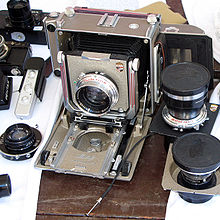| This article includes a list of references, related reading, or external links, but its sources remain unclear because it lacks inline citations. Please help improve this article by introducing more precise citations. (January 2013) (Learn how and when to remove this message) |


A field camera is a view camera that can be folded in a compact size. Modern designs are little different from the first folding field cameras from the 19th century. In general they have more limited camera movements than monorail cameras, but when folded are relatively compact and portable.
Modern field cameras originate from the early interlocking box cameras of the 19th century. Rather than the wooden box used in 19th-century cameras, modern models substitute bellows to reduce the bulk of the cameras and make them easier to use outside the studio.
Although they have less flexibility than monorail cameras, modern field cameras tend to have most camera movements for the front standard, i.e. lens rise/fall/shift/tilt/swing, but are usually more limited in back movements, sometimes having only tilt/swing.
They usually use sheet film, in sizes from 6x9cm (2.4×3.6") to 20×24 inches (e.g., the Polaroid 20×24 camera), but the most popular "standard" sizes are 4×5 and 8×10 inches. They are usually used by photographers who need the larger negative sizes and the portability.
See also
External links
- Field cameras of the United States an in depth look at field cameras from the 19th and 20th century.
This camera-related article is a stub. You can help Misplaced Pages by expanding it. |